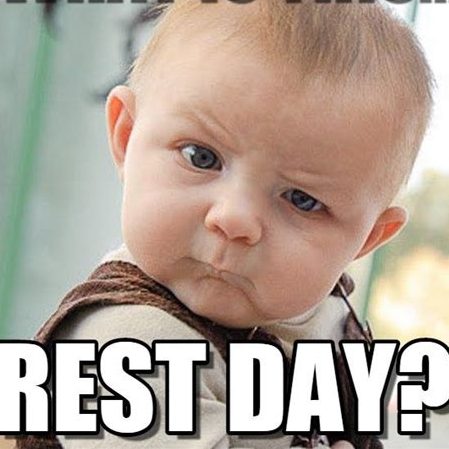
Why are rest days so hard? Anyone who is passionate about some sort of physical endeavor knows that proper rest is key. Especially when working towards building strength or stamina. We know this intellectually, but then our drive/desire/ego gets in the way and we push. And then we push harder. And before we know it, we have pushed too hard, haven’t allowed for the proper amount of rest and recovery, and there we are injured. Sidelined. We have damaged our body so severely we can no longer do whatever is that we love. Rather than take an adequate rest day or two on a regular basis, we are now out of commission for a few weeks, maybe even a few months.
Obviously, prevention is the best medicine, and I think we all know that proper sleeping and eating habits (along with those dreaded rest days) will get you a long way in preventing injuries. Something else that I think is important is the idea of the 70% rule.
Basically the idea is not to put forth 100% of your effort for your entire workout. Give about 70% of what you *could* do to make the session sustainable for its entire duration. AND maybe give 90-100% effort for the few key things that you REALLY want to work on / improve. “Practice today so you can practice tomorrow.” It’s one of my favorite quotes and one that I must remind myself of constantly.
Someone asked me recently what my workout schedule looks like, so I think this may help to clarify the 70% rule. My two current favorites are yoga (obviously) and powerlifting. That may seem like an odd combination but it really isn’t; the two complement each other very well. That said, I’ve also had to find the right BALANCE of the two in order to prevent injury. If my focus is yoga, then I need to back off on what I’m lifting, and change the program to be more for maintenance (not gains). If I want to focus on the lifting, then my yoga practice needs to be more restorative.
Right now my focus is yoga. I powerlift two days per week (squat, bench, deadlift) and for the last two years really haven’t been trying to increase my one rep max. I generally stick to just those three lifts (plus pull-ups — gag) and the only assistance exercises I throw in are to help my YOGA. I aim to practice yoga 4-5 days per week.
Red light! I know you are all doing the math right now. If I lift twice a week and practice yoga 5 times a week, where are the rest days?!? Go back to my 70% rule and the idea of a restorative practice. I might show up to my mat 5 days a week, but I save the vigorous practices for 2-3 days per week (depending on my energy level, amount of time I have, and current state of injury). The other 1 or 2 yoga practices may be restorative or gentle or me taking a class from another teacher with the intention of learning something new (primarily for my TEACHING, not for ME). And those 2-3 vigorous classes? I plan them out ahead of time with specific goals in mind. Am I focusing on backbends? Arm balances? Inversions? Endurance? I know exactly where I want to spend my energy and focus my efforts within that day’s practice — 70% effort for the majority of the session and ramping it up for the things that are important to me on that day. That said, sometimes I show up with a plan and my body has other ideas — and that’s okay — I adjust. The point is, I have a PLAN and an INTENTION.
So what happens when you don’t follow your own advice and the wisdom of your body and you DO get hurt? Let’s be real. It’s going to happen. And I’m guessing that the majority of you reading this are close to my age (or older) and our bodies just aren’t as cooperative or quick healing as they used to be. Sometimes we get injured and have NO IDEA what even caused it. My last two injuries were probably from overuse and there was no big moment where I can pinpoint the exact cause. I just woke up one day and couldn’t do certain movements without searing pain.
My first step (after rest, ice/heat, and ibuprofen of course) is to quickly try to assess what is wrong and diagnose myself. Bear in mind I’m a nurse and have been working with my own body closely for about 10 years. I *generally* know what causes the little tweaks and twinges and can “heal myself” with The Trigger Point Therapy Workbook: Third Edition (Davies, Davies) and a Lacrosse Ball. I usually give those tools about a week to work and USUALLY it does. I’m back to my normal antics within a week or two.
Admittedly, it’s a little bit of trial and error when a new injury pattern arises. I may have to consult the book repeatedly, and find new triggers point to work on. When those things DON’T work, then I have to call in the big guns. Literally. Our most recent home therapy purchase was a massage gun (Renpho R4 Massage gun). We ended up making the purchase a little bit out of desperation on my part, BUT I think it’s actually helped. I spent 6 months trying to work out a hamstring injury and finally caved and went to physical therapy. Even that didn’t really help. But I think the massage gun did. My current injury (something in my rotator cuff?) has proved to be more challenging to heal, and again the massage gun has been able to get at angles the lacrosse ball just doesn’t reach.
While these physical tools are of course necessary to aid the healing process (again, along with that four letter word – REST), we cannot neglect the emotional aspect of being injured. There is absolutely an experience of loss and one may go through all the stages of grief (denial, anger, bargaining, depression, and acceptance). I know this might sound a little extreme, but when there is an activity that you love, so much that you think it defines you, there can be a great sense of loss when you can’t perform that activity. It feels like you have lost a part of yourself. The journey through this grieving process may not be linear, but eventually (hopefully) we reach the acceptance stage which I want to focus on here.
I am no stranger to injuries, nor the process of grief due to said injuries, BUT I have also learned so much from them. Once I get through all the other emotional attachments, I try to look at each injury as just another obstacle. I try to look a little deeper and see what I can learn from the experience. What did I learn physically about my own body? What did I learn about myself in how I handled the set-back and the loss? What did I learn that could be shared with my students in terms of modifications I can offer, or perhaps more empathy in general?
Injuries happen to be a physical limitation — permanent, or temporary — but we also have SO many obstacles in our lives and they can all teach us lessons. We just need to be open and receptive to them. Taking the time to step back and find some perspective may be difficult, but can allow the injuries, obstacles and challenges in our lives to be opportunities for growth. Or you could just those rest days….


